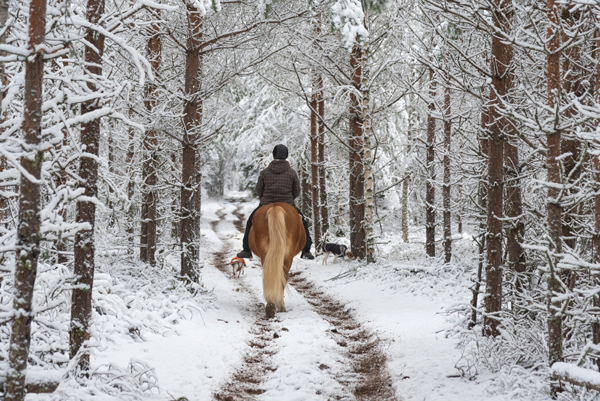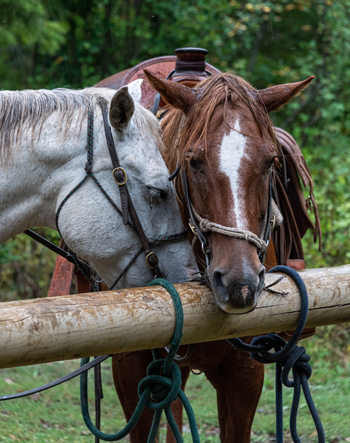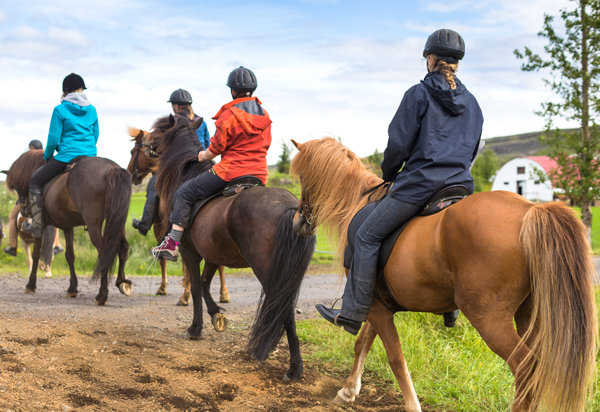
The open trail. Horse, rider and not a fence in sight. Trail riding is a favorite pastime of both equestrians and their loyal mounts. Proper planning bolsters your chances for a successful excursion through nature, but how do you plan for less-than-ideal conditions? Three trail riders share several ways they prepare for trail riding in adverse weather conditions, including wet, hot or cold climates.
Wet Climates
Plan for Daylight—After working for several years as a Central Oregon trail guide, Lowry learned firsthand that daylight disappears fast in the forest. Rain further complicates things.
“I’ve been caught in several situations where you are in the forest and you lose light a lot faster than you think you’re going to,” Lowry says.
Before hitting the trail, she recommends planning out the length of your ride so you can head home before dark. Lowry also suggests checking the forecast for bad weather. If it’s going to be wet, build in time for potentially slick conditions and possible slower going.

Invest in a Fleece Cooler—When rain combines with cold conditions on the trail, it’s important to make sure your horse can keep warm after your ride. Lowry uses fleece coolers during the rainy season to help her horse cool down slowly and prevent chills.
“If you go out and your horse gets wet while you’re riding or they’re overheated for some reason while they’re wet, I really like to put coolers on them when I get back,” she says, adding that coolers are a staple for her in the rainy season.
Watch for Slick Footing—Rain can change a trail in many ways, including the type of footing you and your horse encounter.
“I’m always pretty hesitant to go out where I know there’s going to be an elevation change, just because I know if there’s that red clay, it’s going to be super slick,” Lowry says, referencing a local name for a type of soil found in Oregon.
If you have to navigate a hill with wet, slippery footing, Lowry suggests evaluating your surroundings to see if better footing is available off the main path and giving your horse time to find the best way down.
Bonus Tip: Bring a halter and lead rope. Lowry uses these tools when helping a horse through large puddles or slick areas from the ground.
Hot Climates
Dodging the sun’s intense rays and picking their way through various cactuses, Leah McKeever and her blue roan Quarter Horse mare, Rosie Blue Music Box (Rosie), embrace desert riding. McKeever has lived in Arizona for 20 years and has been riding just as long. During the summer, parts of Arizona reach temperatures that soar into the triple digits. McKeever has learned how to safely navigate the heat so she and Rosie can enjoy the desert trails.
Ride Early—The early bird may get the worm, but during an Arizona summer, the early horse and rider get to trail ride.
“I get there early in the morning and hit the trail before it gets extremely hot,” McKeever says.
Starting and finishing your trail ride before it gets too hot is important, but McKeever also advises budgeting time to trailer home before temperatures rise. The heat can make the trailer uncomfortable or even too hot for your horse, she explains.
Bring Lots of Water—In the desert, water intake is essential. McKeever likes to bring an insulated water bottle along for trail rides. She also verifies water will be available for her horse.
“One thing I always try to make sure of when trail riding is knowing if there will be a water source nearby for my horse to drink water,” McKeever says.
She advises keeping a close watch on the temperature and knowing when it’s time to turn back to prevent dehydration from settling in on you or your horse.
Cover Up—Hot weather may bring tank tops and shorts to mind, but McKeever suggests applying sunscreen and wearing layers when riding under the desert sun. Hats, sunglasses and lightweight, long sleeve pullovers all make her list.
“In the summer it is important to wear layers and cover-up because the sun can, and will, cause damage to your skin,” McKeever says. “I may wear a tank top in the morning before the sun is strong and then throw on a long sleeve as the sun gets stronger.”
Bonus Tip: Carry electrolyte packets. McKeever uses them, as needed, to help her and Rosie stay hydrated during their trail rides.
Cold Climates
Whether navigating forests tightly knit with trees or easing down the slope of a ravine in the plains, Dena Dorn and her sorrel Quarter Horse gelding, Cool King Rebel (Red), love trail riding in Colorado, even in more adverse weather, like cold and snow. Dorn has lived there close to 43 years and has been riding horses for 41. Snow and negative temperatures often accompany Colorado winters. Years of trail riding experience have taught Dorn how to stay safe and enjoy the beauty of winter, even when the temperature dips.

Know the Footing—A beautiful layer of freshly fallen snow covers many things, including the trail. Holes, sticks, rocks or ice can hide from a horse and rider’s sight.
“The hard part about snow is if you haven’t ridden a particular trail or path, then you don’t know what might be underneath,” Dorn says.
To reduce your chances of encountering bad footing, Dorn suggests limiting snow riding to a familiar trail you know is typically wide and clear, or simply ride around the barn.
Check for Ice Balls—Freezing temperatures bring ice balls. Dorn explains that when snow or ice touches the warm sole of a horse’s hoof, they can melt and stick there. They can then re-freeze to the hoof after touching the shoe or cold ground. The process continues until a ball begins to form.
“We’ve seen it where it looks like there’s like a small baseball on the bottom of the feet, and they’re trying to walk on these little balls,” Dorn says.
She recommends periodically pausing during adverse winter weather while trail riding to check for developing ice balls on your horse’s hooves or looking into hoof pads for ice ball prevention. She uses a hoof pick to pry away any balls starting to form.
Wear Layers—During the winter, the temperature in Colorado can fluctuate drastically during the day. Dorn wears layers to avoid going home early due to the cold.
When she trains through the winter, she uses leggings, jeans and three layers on to keep warm.
If your boots don’t allow for wool socks, she advises investing in insulated winter riding boots.
Bonus Tip: Wear sunglasses. Dorn wears sunglasses to protect her eyes from the sun’s intense reflection off of the snow.






Great advice. I have ridden in each of those conditions and had to learn the hard way about the pitfalls. Good reminders for the experienced rider and better get prevention for those new to the trail.
Hand and foot warmers, sheepskin ear covers, knee high insulated boots, and wear your chaps to keep wind off your legs. Do not wear cotton pants if it is snowing.
Back at the barn, spray warm water under horses hoofs to melt ice balls. Horse will like it if you ride him with quarter sheet. Pull it off his back and up to saddle when cantering so he does not sweat. Do not get horse sweaty in cold weather.